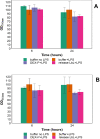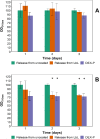Nanoparticle-based model of anti-inflammatory drug releasing LbL coatings for uncemented prosthesis aseptic loosening prevention
- PMID: 31571855
- PMCID: PMC6750844
- DOI: 10.2147/IJN.S217112
Nanoparticle-based model of anti-inflammatory drug releasing LbL coatings for uncemented prosthesis aseptic loosening prevention
Abstract
Introduction: The only treatment for aseptic loosening is the replacement of the prosthesis through revision surgery. A preventive approach, achieved through anti-inflammatory drugs released from the device, has shown to be a viable strategy; however, the performance of these devices is not yet satisfactory thus further improvements are necessary.
Methods: We used titanium nanoparticles as a model for implant surfaces and developed a coating containing dexamethasone (DEX) using layer-by-layer deposition.
Results: The amount of deposited drug depended on the number of layers and the release was sustained for months. The efficiency of the released DEX in reducing inflammation markers (tumor necrosis factor alpha and IL-6) produced by human monocytes and macrophages was similar to the pure drug at the same concentration without negative impacts on the viability and morphology of these cells.
Conclusion: These coatings were not inferior to medical grade titanium (the standard material used in uncemented devices) regarding their ability to sustain osteoblasts and fibroblasts growth.
Keywords: aseptic loosening; cementless prosthesis; dexamethasone; titanium.
© 2019 Alotaibi et al.
Conflict of interest statement
The authors have no conflicts of interest to declare.
Figures








Similar articles
-
Anti-inflammatory drug-eluting implant model system to prevent wear particle-induced periprosthetic osteolysis.Int J Nanomedicine. 2019 Feb 8;14:1069-1084. doi: 10.2147/IJN.S188193. eCollection 2019. Int J Nanomedicine. 2019. PMID: 30804671 Free PMC article.
-
High drug payload nanoparticles formed from dexamethasone-peptide conjugates for the treatment of endotoxin-induced uveitis in rabbit.Int J Nanomedicine. 2019 Jan 14;14:591-603. doi: 10.2147/IJN.S179118. eCollection 2019. Int J Nanomedicine. 2019. PMID: 30666116 Free PMC article.
-
A conductive nanostructured polymer electrodeposited on titanium as a controllable, local drug delivery platform.J Biomed Mater Res A. 2011 Dec 15;99(4):586-97. doi: 10.1002/jbm.a.33210. Epub 2011 Sep 27. J Biomed Mater Res A. 2011. PMID: 21953843
-
Current methods of preventing aseptic loosening and improving osseointegration of titanium implants in cementless total hip arthroplasty: a review.J Int Med Res. 2018 Jun;46(6):2104-2119. doi: 10.1177/0300060517732697. Epub 2017 Nov 3. J Int Med Res. 2018. PMID: 29098919 Free PMC article. Review.
-
Compatibility of the totally replaced hip. Reduction of wear by amorphous diamond coating.Acta Orthop Scand Suppl. 2003 Dec;74(310):1-19. doi: 10.1080/00016470310018108. Acta Orthop Scand Suppl. 2003. PMID: 14768485 Review.
Cited by
-
Layer-by-layer pH-sensitive nanoparticles for drug delivery and controlled release with improved therapeutic efficacy in vivo.Drug Deliv. 2020 Dec;27(1):180-190. doi: 10.1080/10717544.2019.1709922. Drug Deliv. 2020. PMID: 31924103 Free PMC article.
-
Functionalized multidimensional biomaterials for bone microenvironment engineering applications: Focus on osteoimmunomodulation.Front Bioeng Biotechnol. 2022 Nov 4;10:1023231. doi: 10.3389/fbioe.2022.1023231. eCollection 2022. Front Bioeng Biotechnol. 2022. PMID: 36406210 Free PMC article. Review.
-
Nanocomposite orthopaedic bone cement combining long-acting dual antimicrobial drugs.Biomater Adv. 2023 Oct;153:213538. doi: 10.1016/j.bioadv.2023.213538. Epub 2023 Jun 25. Biomater Adv. 2023. PMID: 37390562 Free PMC article.
-
Smart Coatings Prepared via MAPLE Deposition of Polymer Nanocapsules for Light-Induced Release.Molecules. 2021 May 6;26(9):2736. doi: 10.3390/molecules26092736. Molecules. 2021. PMID: 34066573 Free PMC article.
References
-
- UK national joint registry 15th annual report [press release]; 2018.
MeSH terms
Substances
LinkOut - more resources
Full Text Sources

